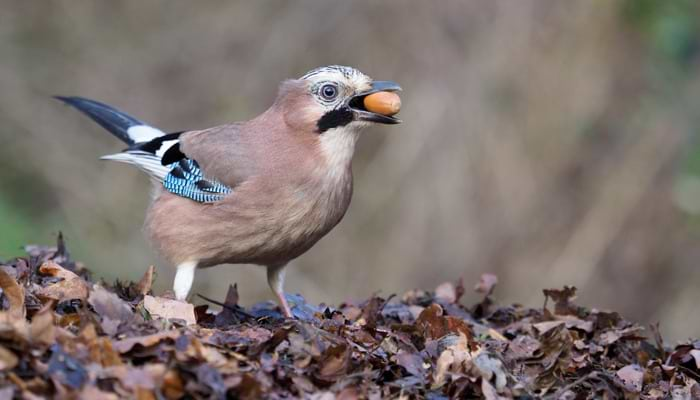
© Erni / Shutterstock.com
One of the crow family's most colourful birds is responsible for planting half the trees in two new English woodlands. The jay is doing the work of hundreds of conservationists, thanks to its natural behaviour of planting acorns that grow into oak trees. Jay birds are helping significantly with the demand to plant more trees to help combat global warming. Scientists monitoring two fields next to Monks Wood nature reserve, in Cambridgeshire, say the process of "passive rewilding" has been hastened by the lively little birds. The former fields have quickly turned into native forest, without the need for plastic tree-guards, expensive management, or watering the land; boosting the case for using natural regeneration to aid woodland creation. The jays have buried acorns in the ground, while thrushes have spread blackthorn, bramble and hawthorn seeds that grow into scrub, which provides natural, thorny guards for the new trees. One field was a former barley field abandoned in 1961, while the other was grassland left to grow wild in 1996. New woodlands The results of the study were published in the Plos One journal, revealing the grassland area had already grown into a young wood, known as the "new wilderness", since 1996. It has 132 trees per hectare and 57% of these are oak trees. Abandoned in 1961, the field is even more amazing, as it has grown into a mature woodland, called "the old wilderness". It has 390 trees per hectare and 52% of them are oaks. Researchers say jays are the "likeliest source" of the oaks in both woods. They carry acorns to bury for the winter much farther than grey squirrels and wood mice can carry them. The research, carried out by the UK Centre for Ecology and Hydrology, points out many people see jays as a pest, by virtue of the fact the acorns and nuts they bury can attract rodents. However, researchers say the woods exist mainly thanks to jays, with a little help from grey squirrels and thrushes. The sites are in line with the government's target to tackle climate change by planting 30,000 hectares of new woodland across Britain by 2024. Spotting a jay Unlike most members of the crow family, the jay is a bright and colourful bird, with pale pink plumage, a white rump and a black tail. A truly multi-coloured bird: it has a pale crown on its head, with black streaks, while it has black and white wings and a panel of electric-blue feathers. It measures 35 cm from tail to beak and has a wingspan of around 55 cm. Jays can be found across most of the UK, all year round. Their favourite habitat is broadleaf woodlands, but they also live in conifer woodlands, scrub and urban areas. While hopping around on the ground, they look for acorns to store for colder weather. Then, they run around looking for places to hide them. Hiding acorns in this manner is called "caching", providing food for the jays when times are lean. However, a lot of acorns are never found again, so the ones that remain buried are left to grow into mighty oak trees. Helping other wildlife The new trees springing up as a result of jays' behaviour benefits other wildlife too. According to Natural England, this type of wood is extremely healthy, because there's no risk of importing diseases. It has cost nothing to plant and grow and it is soon full of wonderful wildlife, including many species of bird, wild plants and pollinating insects. Look out for garden warblers, reed bunting and yellowhammers. Natural woodland also catches harmful CO2 from the atmosphere to help combat global warming. It can also help reduce the risk of floods. Scientists hope the woods that have sprung up at Monks Wood will inspire more natural woodland regeneration across the UK. Natural woodland also creates greater biodiversity benefits, thanks to the wildlife-rich shrubland and oak trees. English oak tree supports more life than any other native tree species in Britain, according to the Woodland Trust, including 31 different species of mammals and more than 2,300 species of plant life. Enjoy some of Britain's beautiful woodlands by taking a winter walk. It can be more enjoyable than you might imagine, as long as you're suitably dressed for the weather - make sure you wrap up warmly!




